Architectural Timber
History and Conservation
Joseph Bispham
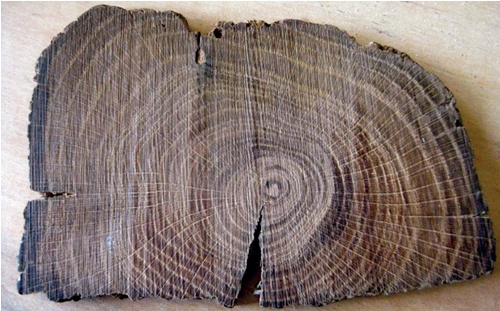 |
|
| Section of an oak beam from Lincoln Cathedral: dendrochronology indicates that the oak was felled in the first quarter of the 13th century. The well-spaced growth rings are typical of faster grown timber from managed woodland. |
The use of European oak and exotic hardwoods as structural and decorative building materials has recently become very popular. Softwood timber, on the other hand, is widely used for cladding, but otherwise its significance as a traditional construction material has been widely overlooked in this timber revival.
The use of softwood as a building material has a long tradition. Historically, imported softwood species such as Pinus Sylvestris (Scots pine, also known as redwood or Baltic pine) were recognised as durable building materials which were easily worked.
With its close vertical grain, softwood made a perfect material for the detailing and paint finishes of the 18th century. Despite the name, many softwoods are also both hard and strong, and are suitable for complex structural use. (The term defines wood from coniferous trees, not soft wood. Indeed hardwoods such as balsa and willow are not hard at all.)
OAK’S GOLDEN AGE
Various timber species were used for construction in medieval England. Oak, elm, sweet chestnut, poplar and the many varieties of fruitwood appear in building accounts from the reign of Henry III. Oak has survived in our medieval buildings to a greater extent than any other timber. It was, and remains, the most popular native hardwood used for the construction of timber frame buildings in England.
The medieval carpenter was able to source construction timber from pollarded trees and from coppicing in locally managed woodland. Coppiced trees are cut down close to the ground leaving the ‘stool’ and they regenerate from shoots that continue to grow from the sides of the stool until they are large enough to be used as timber. In contrast, pollarding involves cutting the tree off at 2-3 metres above ground, protecting the new shoots from grazing animals.
Coppicing would be carried out in an area of ‘underwood’, a lower ‘storey’ of managed trees beneath taller, more widely spaced ‘standards’ that were allowed to grow to maturity. A managed height of approximately 4.5 metres could be worked as an underwood, so every 10-20 years the underwood would be cut to the ground, after which the woodland would produce new growth yielding fresh harvests of wood poles.
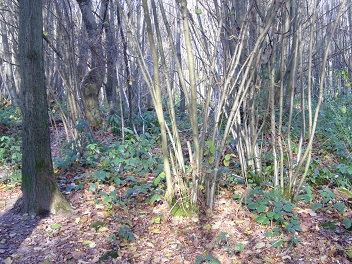 |
|
| Coppiced trees which have been cut back to the ‘stool’ then allowed to regenerate and, in the left foreground, a ‘standard’ which has been left to grow on |
High value trees such as oaks would be selected to grow through the underwood canopy to mature. These trees would develop straight boles (the main part of the trunk before it divides into branches) with fewer branches lower down the trunk and with the crowns much higher. Once felled and converted, these would have been used for the longer sections of timber needed in the construction of timber frame buildings, barns and hall houses. They would also have been of greater monetary value than the unrestricted growth of timber from the field oak.
The history of coppice work has been well recorded since the 12th century, and it is known that pollarding and coppicing gave a regular crop of wood and timber for domestic and building purposes. This type of woodland management and regeneration remained common practice until around 150 years ago.
The widespread use of oak as a construction timber in the past suggests that our ancestors were well aware that oak heartwood is more resistant to rot and beetle infestation. When kept dry, English oak has a longevity that no other native hardwood species enjoys.
Historically, there has always been a demand for English oak for construction and periodically intense demand made it a scarce commodity, particularly when demand for timber for a major project removed all local supplies. The supply of English oak for the construction of the roof of one of the great cathedrals during the middle-ages would have placed a heavy demand on native resources.
In these circumstances, when homegrown supplies were hard to come by, there is evidence that local materials would have been supplemented with oak from abroad. Examples of imported oak timbers have been discovered at Ely and York cathedrals alongside English oak, and English merchants are recorded as visiting and trading at the southern Baltic ports of Elbing (now Elbląg, Poland), Danzig (Gdansk, Poland) and Stralsund (Germany) as early as 1350. By the 15th century Danzig was one of the most important ports exporting timber to England.
USE OF OAK
Much of the oak used in the timber frame construction of dwellings was green oak. When an oak tree is first felled moisture content commonly accounts for half of its weight. The dry weight of oak is constant at 650-800 kg per cubic metre (40-50 lb per cubic foot) but it is not unusual for a freshly felled oak to contain the same weight again in water. In this case the timber would be described as having a moisture content of 100 per cent. (Moisture content is measured by calculating the weight of the water trapped in the cells of the wood as a percentage of its dry weight, so wood can have a moisture content in excess of 100 per cent.)
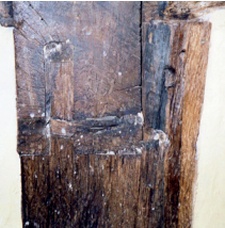 |
|
| One of a pair of posts showing the thickened end of the jowl, formed by the widening of the trunk close to the ground. The end face of the wall plate can be seen (upper left), fixed with a post-head tenon and peg. The tie beam is just visible at the top of the post (upper right). The paler wood at the right-hand edge of the post is sapwood from the outer edge of the tree. |
With such large quantities of water trapped in the wood fibres it would have been impossible to fully season the oak to a dry state in the large sections required for use as beams, girders, and posts, before the construction of a timber frame building took place. Indeed, the framing of many of the timber buildings that survive today in East Anglia was cut and fashioned with green oak. The carpenter would have been very familiar with the benefits of converting and working oak when it is green (unseasoned) as it is much easier to cut and fashion in this state. Oak continues to harden as it dries and as part of the drying process it will move and twist, tightening up the tenon in the mortise joint and giving more strength to the structure.
The size of the timber available was a factor that influenced the scale of the building or hall, in particular the width, which would be governed by the length of timber required for the tie beams. The height of the rooms would also be influenced by the length of the bole of oak for conversion to the required post sizes. In the search for a large-section oak with dimensions above 12 inches square for a principal jowl post, the village carpenter had to use a field oak.
Unlike the oak from managed woodland, field oaks would have been much older as much of its early growth was lateral, and the timber would not be as straight. The timber was converted by cutting or splitting the oak trunk through the middle, lengthways, and upending the timber to display the thickened end that was originally towards the ground. The thick section (or jowl) could then accommodate the tenons of the tie beam and the wall plate. Each tree chosen for this purpose would supply a pair of jowl posts with enough length to accommodate most secular dwellings.
THE DECLINE OF OAK AND THE RISE OF SOFTWOODS
In the 17th century, the consumption of oak for the Elizabethan housing boom, for fuel and for naval ship-building placed even greater demands on the native timber resource. The absence of a reforestation policy compounded the problem. By the end of the century these supply issues had influenced a shift from oak, as the most commonly used constructional timber, to softwood.
However, availability was only one of a number of limitations that had to be overcome to meet the need for new secular timber dwellings of a less important nature. These included the size of available timber and issues concerning the seasoning, conversion and workability of oak. Together, these factors had a direct bearing on the growing trade of imported softwoods into England for use in construction.
The carpenter would have been familiar with these constraints, discussed in more detail below, which influenced the size and character of timber frame constructions.
Availability of timber English expansionism overseas and the war with Spain gave the navy shipyards first call on any quality timber. Navy surveyors became increasingly aggressive in their demands for quality timber (defined by its length, soundness and dimension). A major maritime power for many centuries, England guarded its timber supplies jealously, sometimes even going to war to protect import routes.
Size of available timber The size of a building that could be constructed from timber was dependent on the lengths of straight timber that was available, as outlined above. With the depletion of standards grown in managed woodland, the carpenters were increasingly reliant on field oaks for the largest posts and tie beams, but with branches starting lower down the tree, long straight lengths were increasingly difficult to find locally.
Seasoning, conversion and workability Seasoned oak was much harder than green oak and could not be easily worked, so oak tended to be worked in its green state. While the subsequent shrinkage and distortion of the oak frame contributed to its stiffness, dimensional instability also posed significant problems.
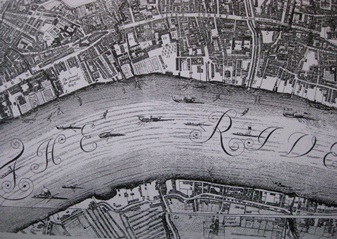 |
|
| Morden and Lea’s 1682 map of central London shows no timber wharfs on the banks of the Thames. Compare John Rocque’s map, below right. |
Softwood, by comparison, dries far more quickly than oak and this reduces its weight and helps to keep it stable. Excellent softwoods were also readily available from abroad. Vast tracts of virgin conifer forest were easily accessible from the Baltic. Never previously harvested, the trees had few branches low down and had very large trunks, so long lengths were available without knots (‘clear’ grades). As they had grown in a cold northern climate with short summers and long winters, the growth rings were tighter and the timber denser than in home-grown softwoods, particularly those from southern England.
Although there was a well-established timber trade between the east coast of Britain and the Scandinavian and Baltic ports by the 16th century, it was not until the middle of the 17th century that imported softwoods became a replacement for the depleted resources of England’s oak forests. Following the Great Fire of 1666, large quantities of softwood timber were imported for the rebuilding of London, and for the estate building that developed to the west of the city from the 17th century.
THE SOFTWOOD BOOM
The record demand for house building in 18th-century London was an indicator of the nation’s prosperity. The demand for buildings resulted in a demand for timber; that timber was pine, felled in Poland and sent to England through the Baltic ports.
The soaring popularity of imported softwood was driven by its quality and availability as well as favourable transport and conversion costs. The quality of slow-grown old-stand timber such as Pinus Sylvestris that was cut inland and sent down river to the Baltic ports of Memel and Riga was recognised by architects and craftsmen of the period. Contemporary specifications (for example by English architect Sir John Soane) called for pine and fir from these ports, including Memel and Riga Fir.
Slow-grown timber with tight growth rings and vertical grain was used extensively for quality joinery such as doors, door-frames and box-sash windows.
From the 17th century imported softwood timber was available from Norway and the Baltic, cut to size using water-driven frame saws. This reduced transport costs and enabled carpenters to access timber with larger sections (baulks).
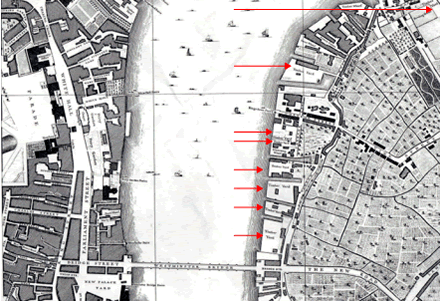 |
|
| John Rocque’s ‘plan of the cities of London and Westminster, and borough of Southwark’, dated 1746, shows the southern bank of the river lined with timber yards (indicated by arrows), timber merchants and framing yards, built to supply England’s burgeoning demand for building timber. |
In the 18th century the use of softwood in carpentry for trussed roofing, trussed beams and trussed partitioning became commonplace. The trussed elements of 18th-century building construction were designed to be of a structural nature and were adopted as a result of architectural influences from Italy where a wider expanse of ceiling was fashionable in the principal rooms.
The mid-18th century saw the publication of many illustrated books promoting new structural and decorative joinery techniques. The principles of trussed roofing, trussed partitioning and trussed beams were well illustrated in books such as Francis Price’s A Treatise on Carpentry (1733), which were produced in great numbers for the craft.
The demand for affordable technical literature such as this demonstrates how 18th-century craftsmen and professionals became engaged in a quest for knowledge in the fields of construction and architectural detailing.
Pattern books also conveyed fashionable London’s architectural styles to the wealthy in all parts of the kingdom and eventually had the effect of regularising architectural style in England through the gentrification of the older properties in villages and towns.
CONSERVATION AND REPAIR OF SOFTWOOD JOINERY
Conservation through repair is an ethic much spoken of, but with regards to the repair of external joinery of historical importance, many people fail to appreciate just how positive and permanent a well-executed repair can be.
One of the most common historic external joinery elements is the box-framed vertical sliding sash window. Neglected rotten window frames are often seen as a burden and simply replaced. However, they can usually be repaired (the rot in softwood joinery is actually often the result of poor maintenance or previous sub-standard repairs), saving both money and well-made historic joinery.
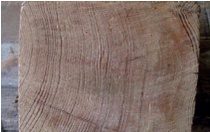 |
|
| Slow-grown old-stand Baltic pine with typically tight grain | |
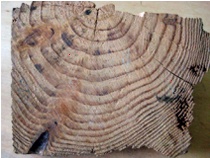 |
|
| The base of a softwood post in a 17th-century timber frame house in Rayleigh, Essex which was converted from managed woodland timber: it shows faster growth in the early years (closer to the centre), with wide early wood growth rings and tighter late wood being produced each year. The tighter growth rings towards the outer edge of the tree indicate slower growth before it was felled. |
To encourage owners to repair (where possible) rather than replace, it is necessary for craftspeople and conservators to impart confidence in the longevity of a well-repaired item. This requires the relevant knowledge to specify the correct repair materials and expertise in the appropriate craft techniques such as the scarfing and joining of new wood to old.
Once a good repair is completed it will serve for as long as the original item is maintained and kept in working order. Given that joinery items can almost always be repaired, what is needed to achieve a successful repair?
Quality of material Much of our historic joinery was constructed from wood that was slow grown. This wood generally has a fine, close-grained texture and, because much of it was from old stands, it tends to be fairly clear of knots and vertically grained, giving it good durability and stability.
Today, managed softwood plantations aim to produce timber as quickly and as economically as possible. This faster grown timber is not as durable as that from the mature trees that were more common up to the start of the 20th century. Much of the modern fastgrown softwood will be used in construction once it has been pressure impregnated with preservatives. Generally this type of timber is not suited to quality repairs of historic joinery. The quality and closeness of grain of repair timber should match that of the original as closely as possible. This will reduce differential movement at the junction of old and new wood.
The last remaining virgin forests in the world are almost all protected, and timber which matches the quality of that used in the past can be difficult to find. Nevertheless, it is still possible to obtain quality material from legal and sustainable sources (see Defra’s Timber Procurement Policy, 1 June 2013) through established timber merchants. Redwood (Pinus Sylvestris) from Sweden, Finland or Russia is a good choice for most joinery repairs. A good alternative is Douglas fir (grade no 2, clear or better). Selection is important and all repair timber should be chosen and inspected piece by piece. Moisture content is particularly important. It is likely that the stocks sourced will have been kiln dried. At the inspection stage moisture readings should be taken of the historic joinery in the zones of sound wood, especially in the areas where the splicing of new to old is to take place. The moisture content in the selected repair timber and in the original wood should correspond to within one or two per cent to avoid subsequent movement.
Craft practice Minimal intervention is a key principle of good conservation practice. However, in the case of joinery repairs some of the sound wood must be removed so that the new wood can be fixed to a sound material, otherwise the repair will fail at the joint between old and new.
Each repair will need to be assessed on its own merit with regards to quality and the run of the grain. Close inspection of the original construction will reveal not only how it was made but also the quality and species of wood used. Any new sections of wood used in the repairs need to be of the same dimensions and matching profiles as the original joinery.
In joining a new section of wood to the original, a method of repair should be chosen so as to remove as little as possible of any mouldings, and this may mean cutting into original timber behind in order to preserve the detail. The success of the repair relies on joining the two pieces of wood together so that new and old wood work together as a single unit. The splice/scarf joint should be cut at a shallow angle running along the grain of the wood. The cut gives a larger surface area with the run of the grain to glue the two faces together. Wherever possible fixings should be to the inner faces or sides. If exterior fixings are required, stainless steel and wooden dowels for tenons should be used.
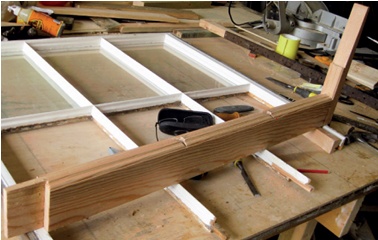 |
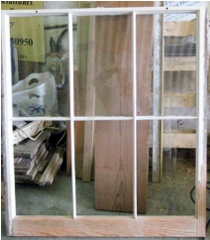 |
|
| Above left: repairing a sash with typical decay at the base: the new section of the stile was spliced to retain as much of the original as possible. This late 18th-century window was made in pine and retained original hand-blown crown glass panes. Above right: The repaired sash ready for priming and painting. | ||
Due to the difficulties of fixing to endgrain, some popular repair methods should be avoided. In particular, some literature illustrates the use of a 45-degree angle cut to join together two pieces of joinery, such as extending the stile of a frame. This amounts to almost endgrain to end-grain fixing and has no life.
Preservative treatment Due to the generally less durable nature of redwood (but not necessarily Douglas fir), the repair timber may be specified as preservative-treated. If this is the case, all the sections of wood that are to be used in the repair would need to be cut and fitted before being disassembled and sent for treatment, so that all the surfaces are properly protected from insect and fungi invasion. Before fixing, it is essential that the preservative-carrying fluids have fully evaporated from the wood allowing it to be glued. With or without preservative treatment, when the repair is complete all the wood must be primed and sealed, especially the end-grain.
Cost Because the success of the repair relies on good quality material, it is well worth paying a little extra for it. Repairs are labour intensive and when set against the labour cost the extra expense of high quality repair material is relatively small.
Longevity Repairs undertaken with quality materials and good craft practices become part of the original structure. There are many excellent carpenters and joiners who can, once shown the methods, complete an extensive repair to these historic elements while drawing personal satisfaction from the process.
~~~
Recommended Reading
RG Albion, Forest and Sea Power: The Timber Problem of the Royal Navy 1652-1862, Harvard University Press, Cambridge (Mass), 1926, p182
J Bispham, Wood Focus, Institute of Wood Science, issue 4, Spring 2001, pp4-5
HM Colvin (ed), Building Accounts of King Henry III, Clarendon, Oxford, 1971
P Dollinger, The German Hansa, Macmillan, London, 1964, p73
English Heritage, Practical Building Conservation: Timber, Ashgate, Farnham, 2012
H Forrester, Timber Framed Houses of Essex, Regency Press, London, 1976
O Rackham, The Ancient Woodland of England: The Woods of South-east Essex, Rochford District Council, Rochford, 1984
WG Simpson and CD Litton, ‘Dendrochronology in Cathedrals’ in The Archaeology of Cathedrals, T Tatton-Brown and J Munby (eds), Oxford University Committee for Archaeology, no 42, 1996, p197
FH Titmuss, Commercial Timbers of the World, Technical Press, London, 1965



